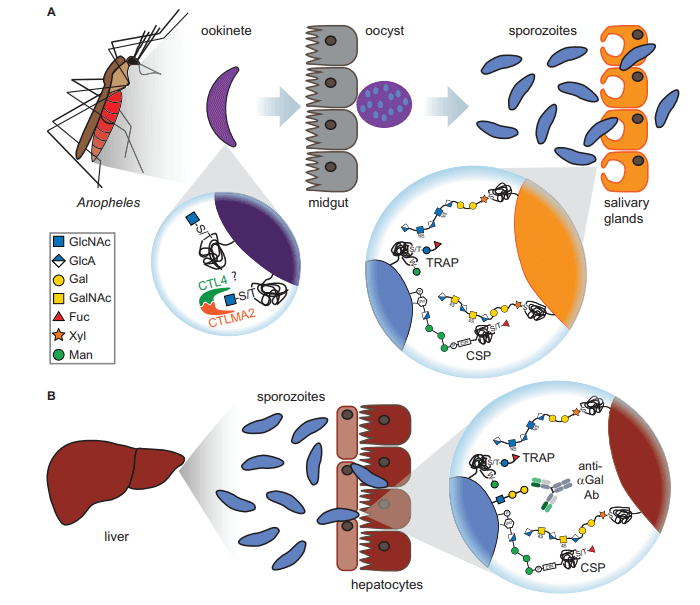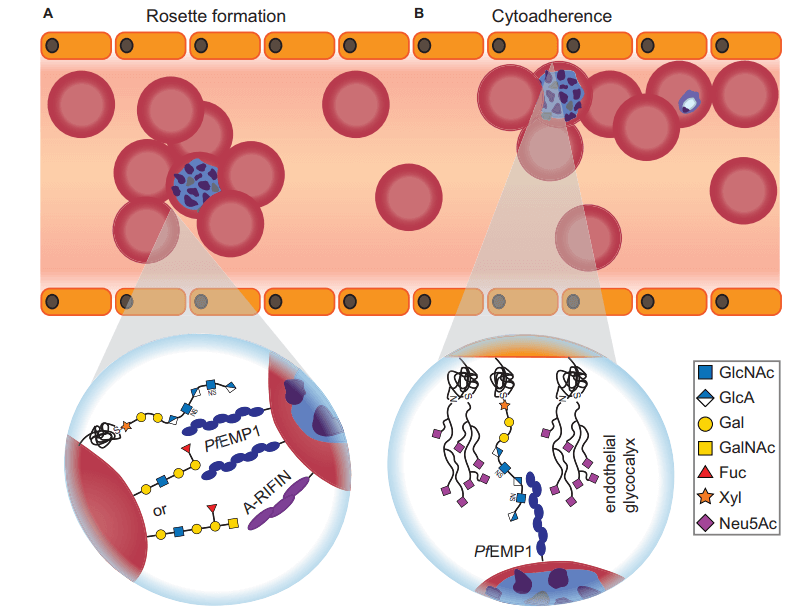Glycan in Parasitic Infection
Infections by parasitic protozoans and helminths are a major worldwide health concern, but no vaccines exist to the major human parasitic diseases, such as malaria, African trypanosomiasis, amebiasis, leishmaniasis, schistosomiasis, and lymphatic filariasis. Glycans play important roles in parasitic infection. Therefore, the anti-parasitic glycans antibodies may be served as a novel immunotherapeutics in parasitic infections diagnosis and treatment. Creative Biolabs has advanced platforms and extensive experience in antibody design and development. Now we can provide high-quality antibody to target parasitic glycans for our customers all over the world. With combined expertise in protein chemistry, immunology, and molecular biology, our scientific team can help you with every step of the development process, from design to validation. Our state-of-art technical platform and professional scientists will be helpful for your projects.
Parasitic Infections and Diseases
Parasites are a kind of organism living the expense of the host, which infect millions of people worldwide and cause much suffering and death, especially in developing countries. The parasitic diseases primarily are divided into two categories, i.e. caused by protozoans (single-celled organisms) and caused by helminths (worms/metazoans). The main classes of protozoan parasites include Plasmodium (causing malaria), Entamoeba histolytica (causing amebiasis), Leishmania (causing leishmaniasis), and Trypanosoma (causing sleeping sickness and Chagas’ disease). Parasitic worms include trematodes (causing schistosomiasis), nematodes (ex. Ascaris lumbricoides), and cestodes or tapeworms (causing taeniasis).
 Fig.1 Glycans at the mosquito and liver stages of Plasmodium.1, 2
Fig.1 Glycans at the mosquito and liver stages of Plasmodium.1, 2
Malaria is caused by Plasmodium species especially Plasmodium falciparum in humans. Malarial parasites have a complicated life cycle, alternating between a sexual reproduction stage in the female Anopheles mosquito vector and an asexual reproduction stage in mammalian tissues (hepatocytes and erythrocytes) and the bloodstream. Cell-cell interactions between the parasite and host are crucial for the successful infection.
African trypanosomes (Trypanosoma brucei) transmitted by blood-sucking tsetse flies are the etiologic agents of nagana disease in cattle and sleeping sickness in humans. A remarkable characteristic of these organisms is their ability to survive extracellularly in the bloodstream of the host, where they are constantly exposed to the immune system. Evasion of the host immune response depends on “antigenic variation,” a highly evolved survival strategy that relies on structural variance of GPI-anchored glycoproteins (variant surface glycoproteins [VSGs]) on the trypanosome surface.
Leishmania infection causes different forms of leishmaniasis, which present clinically in three forms: cutaneous, mucocutaneous, and visceral. Leishmania parasites have a remarkable capacity to avoid destruction in the adverse environments they encounter during their life cycle, alternating between intracellular macrophage parasitism and extracellular life in the gut of their sandfly vector.
Entamoeba histolytica can cause amoebic dysentery and hepatic abscesses, including the disease-inducing amebic or trophozoite stage and the infectious cyst stage. Mature cysts are ingested and inside the host gut, excystation produces the trophozoite that causes pathology. The trophozoites can replicate or form cysts, which are passed via feces to complete the cycle.
Schistosomiasis represents a major parasitic disease related to high morbidity worldwide is caused by parasitic trematodes. Three major species infect humans: Schistosoma japonicum, S. mansoni, and Schistosoma haematobium. Schistosoma is distinct among helminths in that the male and female worms pair to live together in the blood vessels of their host. The infection can induce granulomatous inflammatory responses and portal hypertension and fibrosis, which are characteristic of chronic schistosomiasis and lead to morbidity and often death.
Glycans in Parasitic Infections
Parasites have evolved a variety of survival strategies to escape the vertebrate immune systems to enable long-term survival in infected hosts. Among their strategites via their glycans within glycoproteins and glycolipids that abundant on helminth surfaces and in their excretory/secretory products, to regulate and inhibit host immune responses. Many parasites express unusual and antigenic (nonhost-like) glycans, including those containing polyfucose, tyvelose, terminal GalNAc, phosphorylcholine, methyl groups, and sugars in unusual linkages. In addition, some glycan antigens are expressed possess similar structural features with those in vertebrate hosts (hostlike glycans), such as LeX (Galβ1-4[Fucα1-3]GlcNAc-), LDNF (GalNAcβ1-4[Fucα1-3]GlcNAc-), LDN (GalNAcβ1- 4GlcNAc-), and Tn (GalNAcα1-O-Thr/Ser) antigens. The expressions of host-like glycans render parasites advantages during infection. Glycoconjugates are critical in both the life cycles and pathology of most major parasites. For example, many parasitic protozoans and helminths have elaborated approach to target glycan-binding proteins (GBPs) or glycans in the host to improve parasitism, and to avoid host immune responses. Like other forms of infections (e.g., bacterial or viral), parasite GBPs interact with host glycomes and parasite glycans interact with host GBPs and antibodies. Thus, research on parasite glycobiology and biochemistry could obtain more effective therapeutics for reducing disease morbidity and mortality.
 Fig.2 Glycan-dependent interactions between Plasmodium-infected RBCs and uninfected host cells.1, 2
Fig.2 Glycan-dependent interactions between Plasmodium-infected RBCs and uninfected host cells.1, 2
The glycan antigens of many parasites are being used to develop vaccines or specific antibodies for diseases diagnostics and treatment. For example, the major antigenic glycoconjugates synthesized by larvae of the parasitic nematodes Toxocara canis and Toxocara cati are O-methylated trisaccharides that contain 2-O-methyl fucosyl and galactosyl residues. The intestinal nematode Trichinella spiralis synthesizes several highly immunogenic glycoproteins carrying complex N-glycans containing the unusual sugar tyvelose (3,6-dideoxy-D-arabino-hexose). This structure is critical to induce a strong antibody response to these glycans, which results in expulsion of the invading larvae from the intestine and results in protective immunity.
Features of Our Services
- Advanced antibodies development platform
- High specificity and high affinity
- High-quality and one-stop service
- Timely and cost-effective
Creative Biolabs is a leading service provider in the field of antibody generation, we have more than ten years’ research and development experience. Now we offer high-quality antibodies to target parasitic glycans for disease diagnosis and therapy. To fulfill customers' demands, we have developed more than ten host species on our platform. If none of them meets your requirement, our experienced scientists will be glad to work out a customized solution for you. Please feel free to contact us for more details.
References:
- Goerdeler, Felix, Peter H. Seeberger, and Oren Moscovitz. "Unveiling the sugary secrets of Plasmodium parasites." Frontiers in microbiology 12 (2021): 712538.
- Distributed under Open Access license CC BY 4.0, without modification.
